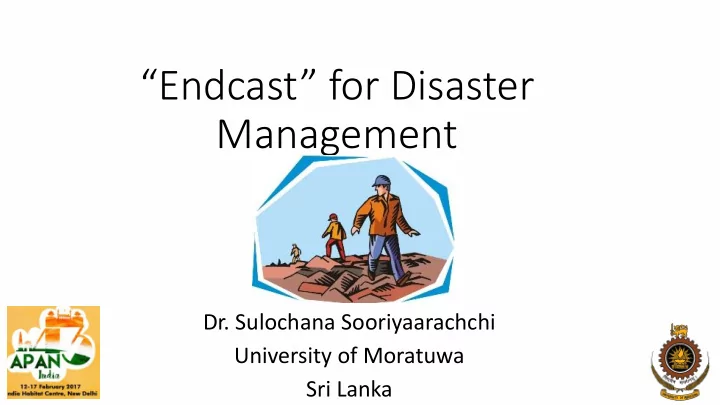

“ Endcast ” for Disaster Management Dr. Sulochana Sooriyaarachchi University of Moratuwa Sri Lanka
Outline • Disaster scenario • Mobile Adhoc Networks (MANET) for communication • Traditional MANET routing • Mobile stateless routing • Endcast • Proposed endcast protocol • Simulation results • Conclusions
Disaster Scenario • A medical team member contacting food team ? • Damaged infrastructure • Large crowd • Low power devices A dense MANET
Routing in dense MANETs • Traditional routing • Proactive • Reactive • Hybrid • Costs • Route discovery, maintenance, control overhead, frequent updates, node hierarchies No robust unicast mechanism MANETs almost not deployed
Novel approach: mobile stateless routing • No route discovery and maintenance • No node hierarchies • No global states (e.g. routing tables) • No special nodes Blind rebroadcasting Free to go Mobile! Simple flooding ? How?
Efficient flooding schemes
Endcast • Unicast : a single sender and a single receiver through point to point path • Anycast : a single sender to any one of a group of receivers • Multicast : a single sender to a group of receivers • Broadcast: a single sender to all members of the network • Endcast : a single sender via all or some intermediate receivers to a single destination
Problems in endcast Broadcast storm condition Broadcast flood condition Propagation of the messages beyond The serious redundancy, contention and the destination (we defined) collision that occur in fooding networks [1]
An endcast scheme • Simplest mobile-stateless mechanism blind rebroadcasting • Broadcast storm control biologically inspired mechanisms • Broadcast flood control negative acknowledgement
Biological inspirations for storm control
Cell proliferation Vs blind rebroadcasting • Cell proliferation : cells increase in number due to division into two identical cells On what basis our ears stop growing after reaching a particular size?" • Growth regulation using chalone mechanism
Chalone Mechanism • Cells secrete a molecule called chalone • Chalone concentration increases with number of cells • Cells stop proliferating when the chalone concentration reaches a threshold
Mapping from biological system to MANET
Flood control by inhibition • Negative acknowledgement messages inhibitor • Propagates via counter-based flooding • Inhibitor size < data frame • Inhibitor wait < chalone wait • Inhibitor is rebroadcast only when there are relevant log records
Protocol highlights • Chalone wait: RAD for assessing frame count selected uniformly from the range 0 to Tmax • Chalone threshold: Adjust to tradeoff between redundancy and reachability • Inhibitor wait: Should be less than chalone wait to catch and stop flooding wave • Data buffer: Frame to be buffered until rebroadcast decision • Frame log:
State transition diagram
Simulation study • In ideal network conditions • In realistic network conditions
Simulation results - effect of storm control
Simulation results - effect of flood control
Simulation results - effect of chalone threshold
Simulation results - effect of mobility
Comparison of proposed protocol with routing approaches • Fixed-stateful paradigm: key nodes to perform routing, keep global states e.g. routing tables • Mobile-stateless paradigm: nodes are free to move, no special roles to play, no global states maintained • Proposed protocol: local state (frame log), no key nodes, no global states
Conclusion • Proposed the concept of endcast for mobile-stateless routing • Built a theoretical model for endcast to model and analyse • the effect of mobility on flooding performance • the effect of MAC layer characteristics on flooding operation • the effect of efficient flooding parameters on flooding performance • time domain aspects (e.g. RAD) • broadcast storm and flood problems in endcast • Limitations and future research • Applying the complete model on proposed protocol • Testing the protocol on a real testbed
Q&A
Acknowledgement • APAN for fellowship • LEARN for airfare support • Dr. Chandana Gamage – research supervisor • Prof. Gihan Dias – encouraged APAN participation • CITes (University of Moratuwa NoC) • Dr. Shantha Fernando, Mr. Sarada, Mr. Nadeesha • Colleagues at CSE and UoM • Your attention!
Thank you
Recommend
More recommend